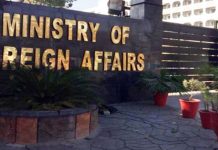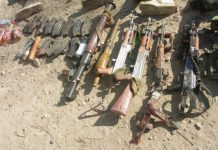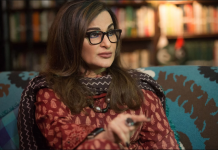ISLAMABAD: As the world scrambles to deal with the coronavirus pandemic, fear and anxiety prevail in Indian Occupied Kashmir after four COVID-19 cases were detected.
Hospitals in the disputed Himalayan region have an acute shortage of doctors and paramedics, while its healthcare facilities are insufficient to meet the crisis which has unsettled countries with world-class medical infrastructure, Kashmir Media Service reported.
Given the situation, residents of the valley fear the potentially disastrous consequences of the coronavirus pandemic after the first case of infection was reported on March 19.
Apprehensions abound that this may be just the “tip of the iceberg” as several hundred people, most of whom had traveled to other countries, were placed under quarantine. In nearby Laddakh, which until August was part of Kashmir before it was separated and turned into a federally-administered territory, 13 cases tested positive, most of whom had traveled to Iran.
The Muslim-majority region has been under a strict security and communication lock-down since August 5 when New Delhi stripped the disputed Himalayan region’s of its special status. The internet was restored earlier this month, but it remains slow as 4G services are still not allowed.
Srinagar, Indian-occupied Kashmir’s main city and home to a million people, turned into a ghost town this week as markets were shut, public transport banned and entry of travellers restricted.
“We aren’t testing proactively and enough,” Junaid Mattu, mayor of Srinagar, said. “We aren’t preparing for the worst.” The valley’s administration, which now reports to New Delhi, has taken a series of measures aimed at containing the spread of the virus, including a lockdown that has grown in recent days.
The fear over the pandemic is compounded by a feeling among Kashmiris that the administration is not being transparent with them.
“Trust me, if I share a summary of daily events, no one in Kashmir will sleep,” Shahid Chaudhary, head of the civil administration in Srinagar, wrote on Twitter.
“Let’s keep our egos aside, work collectively and instead of raising panic and alarm help each other to improve. This (is) 3rd World War. Nothing less.”
The real crisis, however, may well lie in Kashmir’s hospitals, which remain understaffed and ill-equipped to fight the outbreak. A veteran doctor, the former principal of Government Medical College (GMC) in Srinagar who is acquainted with the region’s healthcare facilities, warned that a major disaster could occur.
The college has seven major hospitals associated with it. “We need lock-down for one month,” he told media on condition of anonymity. “If it [coronavirus pandemic] happens here, we will be devastated. We will die like cattle.”
“It will crush us and devastate us, unless the community intervenes,” he said. Samia Rashid, current GMC principal, said the outpatient department and all elective surgeries have been suspended in the associate hospitals.
“Only emergencies will be examined and cancer surgeries performed. Patients who do not require immediate treatment are requested to not visit hospitals,” she urged. Rashid said the GMC administration has “more than 13,000 N95 masks, 3,300 Personal Protective Equipment (PPE) kits,” adding that they also procured 122,000 triple layered masks.
Rashid said that while there were enough ventilators “to contain the situation right now”, there was a shortage of manpower. “Our manpower to run them all is not sufficient.” An official audit of healthcare facilities conducted in 2018 found that the existing manpower was “barely sufficient to run the health institutions in view of sustained increase of patient flow across the state”.
“[Kashmir] is severely short of nursing staff. Against a requirement of 3,193 nurses there are only 1,290 sanctioned posts of staff nurses in the territory with a deficit of 1,903 posts which need to be created,” the audit found.
The audit noted that the doctor to patient ratio in the Kashmir region is one of the lowest in India. “Compared to the doctor-patient ratio of 1:2,000 in India, occupied Kashmir has one allopathic doctor for 3,866 people against the WHO norm of one doctor for 1,000 population,” it said. Doctors fear going home Ahmad, a doctor at Srinagar’s Shri Maharaja Hari Singh Hospital, told media doctors fear going home after work. “We do not have the required protective equipment. We just wear a surgical mask, normal gloves and surgical gown and a cap. We cannot tell a patient to maintain distance,” he said. “It is the first place where people come with symptoms and their first contact with a doctor”. Ahmad said doctors like him are at risk of being exposed to coronavirus infection and “do not want to be the carrier of the virus”.
“If we get infected, the whole hospital staff would have to be quarantined. We need proper equipment so that the health system keeps going,” he told Al Jazeera.
The Resident Doctors Association at the hospital, in a statement, this week said “every patient visiting the hospital should be viewed as a potential COVID-19 case” and rued the dearth of protective infrastructure and sanitisers at the hospital.
“Welfare of public depends on doctors, and if doctors themselves are sick, how can they provide healthcare to general public.” At the region’s two major hospitals, which see thousands of patients daily from across Kashmir, two doctors have been put in quarantine after they developed symptoms of COVID-19.
Amid the alarming threat of the spread of COVID-19, Kashmir also faces a crippling blockade of high-speed internet which has effectively hampered an effective awareness campaign among the people as well as among doctors.




